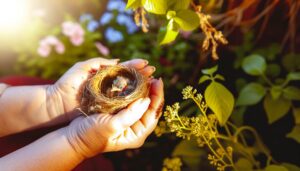Focely Open a Baby Sparrow’s Beak in 3 Steps
To safely open a baby sparrow's beak, gather a feeding syringe, soft feeding formula, and a small towel. Sterilize all implements.
In a quiet, dimly lit room at 85°F, lay the sparrow on a clean cloth. Cradle its body with your non-dominant hand and support the head with your dominant hand.
Apply minimal pressure to either side of the beak with your thumb and forefinger, stimulating a natural feeding response. Tap the beak's tip or stroke the throat if it remains closed.
Continue to explore for more detailed steps and effective feeding techniques.
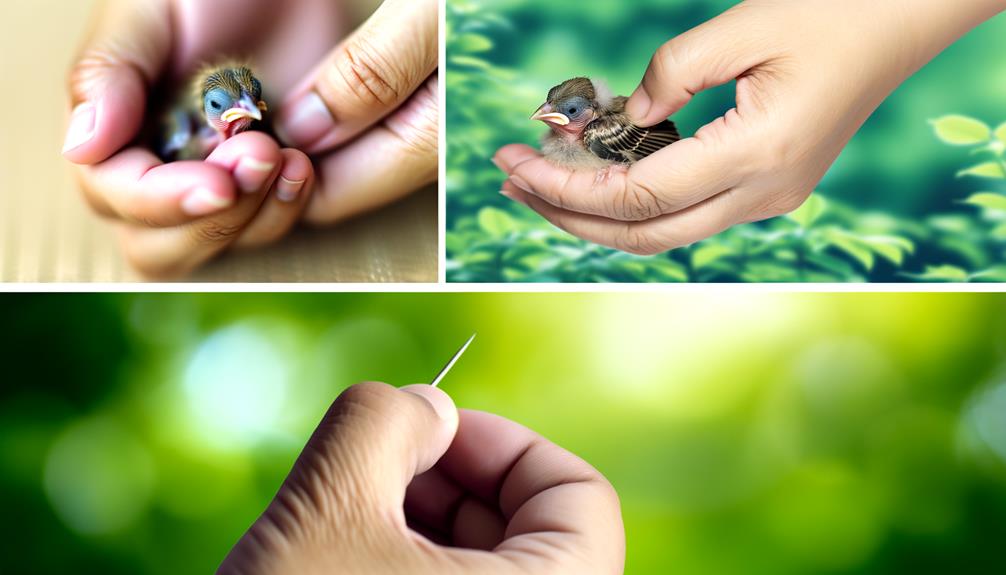
Key Takeaways
- Apply gentle pressure on either side of the beak using your thumb and forefinger.
- Lightly tap the tip of the beak to stimulate a natural feeding response.
- Stroke the throat area to encourage the sparrow to open its beak.
- Exert minimal force to avoid causing stress or injury to the bird.
- Maintain a calm and quiet environment to keep the sparrow relaxed.
Gathering Necessary Supplies
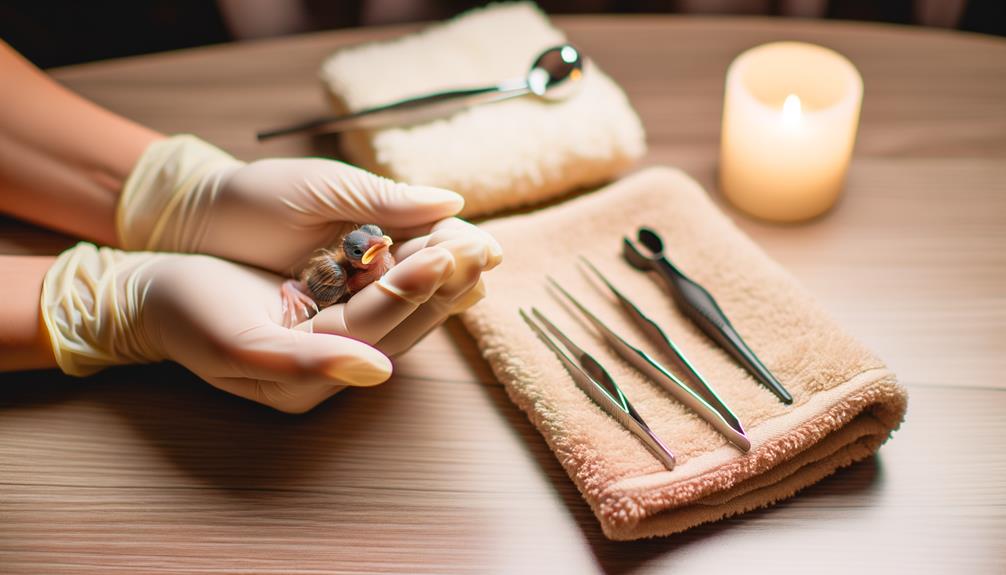
Before attempting to open a baby sparrow's beak, make certain you have gathered essential supplies such as a feeding syringe, soft feeding formula, and a small towel for gentle restraint.
The feeding syringe should be sterilized to prevent infections. Opt for a soft feeding formula designed for baby birds, making sure it contains balanced nutrients. The small towel aids in restraining the bird gently, minimizing stress and potential injury.
To prepare, lay out your supplies within easy reach to streamline the process. Each item has a specific role: the syringe delivers precise food amounts, the formula provides essential nourishment, and the towel ensures the bird remains calm.
Proper preparation reflects your dedication to the sparrow's well-being and successful feeding.
Preparing Your Environment
Having gathered the necessary supplies, now focus on creating a calm and controlled environment to guarantee a stress-free feeding session for the baby sparrow.
First, choose a quiet, dimly lit room to minimize distractions and reduce the bird's stress levels. Assure the ambient temperature is around 85°F to mimic the natural warmth of a nest. Sterilize all feeding implements to prevent bacterial contamination.
Lay out a soft, clean cloth on a stable surface to provide a comfortable area for the sparrow. Keep a small light source at hand to illuminate the sparrow's beak without causing discomfort.
Maintain a gentle demeanor and speak in soothing tones to foster a sense of security. This preparation sets the stage for a successful feeding.
Proper Hand Positioning
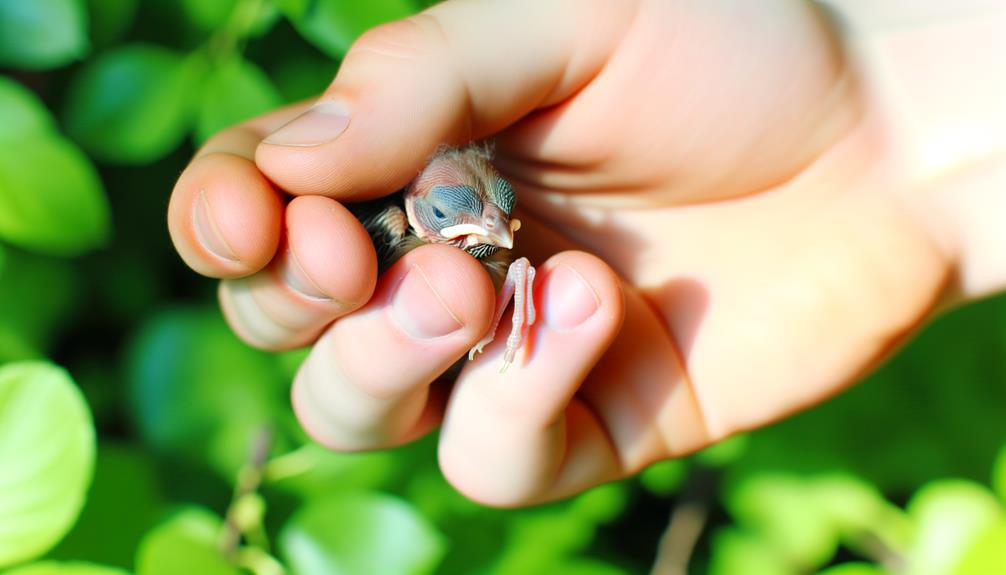
To ensure you can safely open the baby sparrow's beak, position your hands with one gently cradling the bird's body and the other stabilizing its head. This technique minimizes stress and guarantees the bird's safety.
Follow these steps for proper hand positioning:
- Gently cradle the body: Use your non-dominant hand to support the sparrow's body, making sure the legs and wings are secure but not restrained.
- Support the head: With your thumb and forefinger of the dominant hand, gently hold the head just below the beak.
- Maintain stability: Keep your hands steady to prevent sudden movements that could startle the bird.
- Monitor the bird's comfort: Continuously observe the sparrow for signs of distress, adjusting your grip as necessary.
Proper hand positioning is essential for the sparrow's well-being.
Gently Opening the Beak
With your hands properly positioned, gently apply slight pressure on either side of the baby sparrow's beak to encourage it to open. Use your thumb and forefinger, exerting minimal force to avoid causing distress or injury. Be patient; the aim is to stimulate a natural feeding response.
If the beak remains closed, try lightly tapping the beak's tip or stroking the throat area. These actions can trigger the instinctual gape reflex, making it easier to open the beak.
Create a calm environment to keep the bird relaxed. Consistent gentle attempts will build trust and reduce resistance over time.
Always monitor the sparrow for signs of stress, and discontinue if it appears overly agitated.
Feeding Techniques
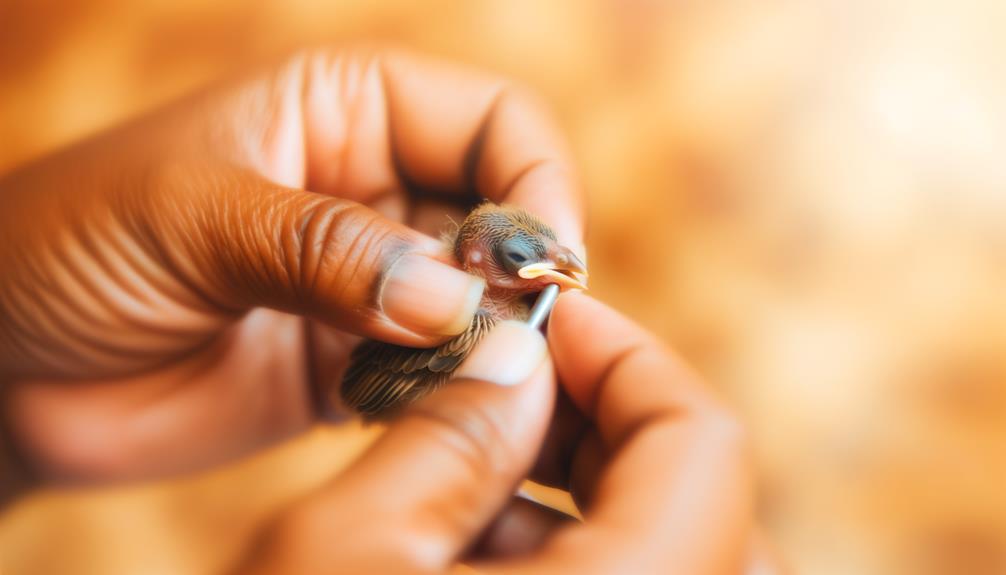
Effective feeding techniques for baby sparrows require precision, patience, and the correct tools to guarantee their nutritional needs are met. First, make sure the food is at the proper consistency by mixing it with warm water until it forms a smooth paste.
Using a syringe or dropper, follow these steps:
- Positioning: Hold the sparrow gently with its head slightly elevated.
- Feeding Tool: Use a syringe or dropper with a fine tip to avoid choking.
- Small Amounts: Administer modest portions of food, aiming for the side of the beak.
- Frequency: Feed every 2-3 hours, adjusting based on the sparrow's age.
Post-Care Steps
After making sure the baby sparrow has been well-fed, you must focus on maintaining a clean and safe environment to support its health and development.
Sterilize the feeding tools after each use to prevent bacterial growth.
Keep the nesting area dry and free of droppings by replacing the bedding daily with soft tissues or paper towels.
Monitor the ambient temperature, maintaining it around 85°F (29°C) using a heat lamp or pad.
Hydrate the sparrow by offering water droplets on a small brush.
Observe its behavior for signs of distress or illness, such as lethargy or abnormal droppings.
Consult a wildlife rehabilitator if symptoms persist.
Your careful attention guarantees the sparrow's successful growth and eventual return to the wild.
Conclusion
Think of the baby sparrow's beak as a delicate flower bud.
By following these steps:
- Gathering your supplies,
- Preparing your environment,
- Positioning your hands,
- Gently opening the beak,
- Employing proper feeding techniques, and
- Guaranteeing post-care,
you nurture that bud into a thriving blossom.
Your meticulous care symbolizes the nurturing hand of nature itself, guiding the vulnerable towards growth.
This method, grounded in evidence-based practices, secures the bird's well-being and fosters its journey to maturity.




